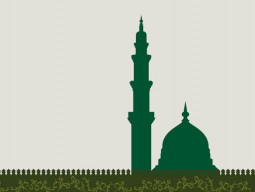
Nobody could have thought that Rasheed Amjad, who once asked Mansha Yaad, the distinguished writer, what a short story was, would one day become a leading short story writer.
Born in Srinagar in Indian Kashmir in 1940, Amjad’s first short story was published in Adab-e-Latif in 1960 which, according to the renowned writer, “did not elicit a positive response from the public.”
Amjad continued writing about current events and later switched to a more symbolic form of writing for which he gained fame in the literary circle.
Recalling the reaction of readers to the symbolic form of writing, Amjad said readers at that time were accustomed to conventional writing but in time modern symbolic short stories appeared that won mass appeal.

“At that time, the progressive writers’ movement was at its peak. Symbolic writing emerged as a reaction to greater emphasis on objectivity rather than on subjectivity — the hallmark of conventional writing.”
Gen. (retd) Ayub Khan’s martial law inadvertently promoted elliptical techniques to express ideas that were impossible to convey directly,” he stated.
The rulers were afraid of Urdu ghazal as poets expressed opinions against the Raj without being explicit, said Amjad. He believes that words become meaningless if they are continuously written in the same style and that great writers do not stick to established principles, evolving their unique styles.
According to Amjad, the 1930s saw the rise of short story writers of great repute. There has never been a congregation of renowned Urdu language writers in any period after that.
“From partition to 1960, around 100 short stories can be described as classic. Those which can survive the test of time become classics, he said. In the same way, around 50 short stories may be called literary masterpieces to the present day.”
Amjad said he was most influenced by Manto, Ghulam Abbas, Ahmad Nadeem Qasmi, Rajinder Singh Bedi and Asmat Chughtai.
He lamented the dearth of good translators who could translate Urdu short stories, some of which have no parallel in world literature.
Published in The Express Tribune, October 3rd, 2013.
COMMENTS (13)
Comments are moderated and generally will be posted if they are on-topic and not abusive.
For more information, please see our Comments FAQ


1725443747-0/Untitled-design-(5)1725443747-0-165x106.webp)














Rasheed Amjad sees life through his own spectacles and shares his experiences, good or bad,with us. Being a keen observer of his surroundings he shares with us everything which haunts him -- be it politics or love.
Rasheed Amjad’s beauty is his resounding sentences filled with close-to-life realities.
Rasheed Amjad's selective approach and highly personal ideas make some of his short stories a bit enigmatic, which a common reader is unable to digest.
Through innovative prose cadence and linguistic style Rasheed Amjad has developed an individual technique of his own. His role in the formation of fresh trends in story writing in Urdu literature has been excellent.
I know Rasheed Amjad from the days when he used to attend literary circles. He and his art of story telling has grown marvelously.
Rasheed Amjad is unique in the selection of his topics and style. Down the hill politics, oppression and suppression, the upheaval in the values of culture and civilization, lost identity, direction-less society, social devastation and unidentifiable age are some of his favorite topics. His short stories are a comment on our 6-drcade old history. He is my favorite writer.
Although Rasheed Amjad's short stories are too difficult to understand because of symbolism, as every symbolic writing has been, but his brighter aspect is that he uses local symbols thus making easy for the readers to get his message. He is, indeed, a great short story writer with a style of his own..
Rasheed Amjad was my Ustad. It would have been better if ET had provided a little detailed comments about his work and literary standing quoting some examples from his writings. He is really a master of symbolism, of course.